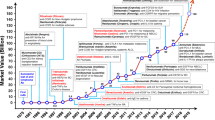Abstract
Drug abuse continues to be a major national and worldwide problem, and effective treatment strategies are badly needed. Antibodies are promising therapies for the treatment of medical problems caused by drug abuse, with several candidates in preclinical and early clinical trials. Monoclonal antibodies can be designed that have customized affinity and specificity against drugs of abuse, and because antibodies can be designed in various forms, in vivo pharmacokinetic characteristics can be tailored to suit specific clinical applications (eg, long-acting for relapse prevention, or short-acting for overdose). Passive immunization with antibodies against drugs of abuse has several advantages over active immunization, but because large doses of monoclonal antibodies may be needed for each patient, efficient antibody production technology is essential. In this minireview we discuss some of the antibody forms that may be effective clinical treatments for drug abuse, as well as several current and emerging production systems that could bridge the gap from discovery to patient use.
Similar content being viewed by others
References
Pentel P, Malin D. A vaccine for nicotine dependence: targeting the drug rather than the brain.Respiration (Herrlisheim). 2002;69:193–197.
Hieda Y, Keyler DE, Ennifar S, Fattom A, Pentel PR. Vaccination against nicotine during continued nicotine administration in rats: immunogenicity of the vaccine and effects on nicotine distribution to brain.Int J Immunopharmacol. 2000;22:809–819.
McClurkan MB, Valentine JL, Arnold L, Owens SM. Disposition of a monoclonal anti-phencyclidine Fab fragment of immunoglobulin G in rats.J Pharmacol Exp Ther. 1993;266:1439–1445.
Valentine JL, Mayersohn M, Wessinger WD, Arnold LW, Owens SM. Antiphencyclidine monoclonal Fab fragments reverse phencyclidine-induced behavioral effects and ataxia in rats.J Pharmacol Exp Ther. 1996;278:709–716.
Byrnes-Blake KA, Laurenzana EM, Carroll FI, et al. Pharmacodynamic mechanisms of monoclonal antibody-based antagonism of (+)-methamphetamine in rats.Eur J Pharmacol. 2003;461:119–128.
McMillan DE, Hardwick WC, Li M, Owens SM. Pharmacokinetic antagonism of (+)-methamphetamine discrimination by a low-affinity monoclonal anti-methamphetamine antibody.Behav Pharmacol. 2002;13:465–473.
Roskos LK, Davis CG, Schwab GM. The clinical pharmacology of therapeutic monoclonal antibodies.Drug Dev Res. 2004;61:108–120.
Brambell FW, Hemmings WA, Morris IG. A theoretical model of gamma-globulin catabolism.Nature. 1964;203:1352–1354.
Junghans RP. Finally! The Brambell receptor (FcRB). Mediator of transmission of immunity and protection from catabolism for IgG.Immunol Res. 1997;16:29–57.
Ghetie V, Ward ES. Transcytosis and catabolism of antibody.Immunol Res. 2002;25:97–113.
Trang J. Pharmacokinetics and metabolism of therapeutic and diagnostic antibodies. In: Ferraiolo B, Mohler M, Gloff C, eds.Protein Pharmacokinetics and Metabolism. New York, NY: Plenum Press; 1992;223–270.
Weiner LM. Monoclonal antibody therapy of cancer.Semin Oncol. 1999;26:43–51.
Stein KE. Immunogenicity: concepts/issues/concerns.Dev Biol (Basel). 2002;109:15–23.
Kuus-Reichel K, Grauer LS, Karavodin LM, Knott C, Krusemeier M, Kay NE. Will immunogenicity limit the use, efficacy, and future development of therapeutic monoclonal antibodies?Clin Diagn Lab Immunol. 1994;1:365–372.
King DJ, Byron OD, Mountain A, et al. Expression, purification and characterization of B72.3 Fv fragments.Biochem J. 1993;290:723–729.
Kadokura H, Katzen F, Beckwith J. Protein disulfide bond formation in prokaryotes.Annu Rev Biochem. 2003;72:111–135.
Simmons LC, Reilly D, Klimowski L, et al. Expression of full-length immunoglobulins inEscherichia coli: rapid and efficient production of aglycosylated antibodies.J Immunol Methods. 2002;263:133–147.
Venturi M, Seifert C, Hunte C. High level production of functional antibody Fab fragments in an oxidizing bacterial cytoplasm.J Mol Biol. 2002;315:1–8.
Cereghino GP, Cereghino JL, Ilgen C, Cregg JM. Production of recombinant proteins in fermenter cultures of the yeastPichia pastoris.Curr Opin Biotechnol. 2002;13:329–332.
Peterson EC, Farrance C, Henry R, Owens SM. Engineering of a single chain antibody for treatment of methamphetamine abuse. 2004 Experimental Biology meeting abstracts [on CD-ROM].FASEB J. 2004;18: Abstract 397.1
Damasceno LM, Pla I, Chang HJ, et al. An optimized fermentation process for high-level production of a single-chain Fv antibody fragment inPichia pastoris.Protein Expr Purif. 2004;37:18–26.
Joosten V, Lokman C, Van Den Hondel CA, Punt PJ. The production of antibody fragments and antibody fusion proteins by yeasts and filamentous fungi.Microb Cell Fact. 2003;2:1.
Murasugi A, Asami Y, Mera-Kikuchi Y. Production of recombinant human bile salt-stimulated lipase inPichia pastoris.Protein Expr Purif. 2001;23:282–288.
Ma JK, Drake PM, Christon P. The production of recombinant pharmaceutical proteins in plants.Nat Rev Genet. 2003;4:794–805.
Gleba Y, Klimyuk V, Marillonnet S. Magnifection—a new platform for expressing recombinant vaccines in plants.Vaccine. 2005;23:2042–2048.
Gleba Y, Marillonnet S, Klimyuk V. Engineering viral expression vectors for plants: the ‘full virus’ and the ‘deconstructed virus’ strategies.Curr Opin Plant Biol. 2004;7:182–188.
Marillonnet S, Thoeringer C, Kandzia R, Klimyuk V, Gleba Y. Systemic Agrobacterium tumefaciens-mediated transfection of viral replicons for efficient transient expression in plants.Nat Biotechnol. 2005;23:718–723.
Santi L, Giritch A, Roy CJ, et al. Protection conferred by recombinant Yersinia pestis antigens produced by a rapid and highly scalable plant expression system.Proc Natl Acad Sci USA. 2006;103:861–866.
Gils M, Kandzia R, Marillonnet S, Klimyuk V, Gleba Y. High-yield production of authentic human growth hormone using a plant virus-based expression system.Plant Biotechnol J. 2005;3:613–620.
Sharp JM, Doran PM. Characterization of monoclonal antibody fragments produced by plant cells.Biotechnol Bioeng. 2001;73:338–346.
Derouazi M, Girard P, Van Tilborgh F, et al. Serum-free large-scale transient transfection of CHO cells.Biotechnol Bioeng. 2004;87:537–545.
Baldi L, Muller N, Picasso S, et al. Transient gene expression in suspension HEK-293 cells: application to large-scale protein production.Biotechnol Prog. 2005;21:148–153.
Author information
Authors and Affiliations
Corresponding author
Additional information
Published: May 26, 2006
Rights and permissions
About this article
Cite this article
Peterson, E., Owens, S.M. & Henry, R.L. Monoclonal antibody form and function: Manufacturing the right antibodies for treating drug abuse. AAPS J 8, 43 (2006). https://doi.org/10.1007/BF02854909
Received:
Accepted:
DOI: https://doi.org/10.1007/BF02854909




